Page 50 of 388
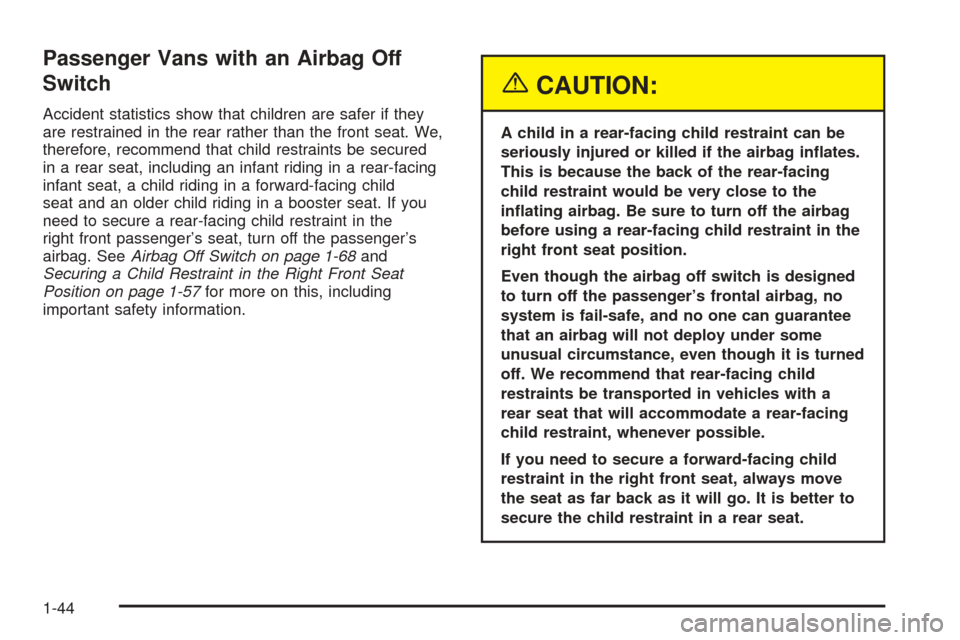
Passenger Vans with an Airbag Off
Switch
Accident statistics show that children are safer if they
are restrained in the rear rather than the front seat. We,
therefore, recommend that child restraints be secured
in a rear seat, including an infant riding in a rear-facing
infant seat, a child riding in a forward-facing child
seat and an older child riding in a booster seat. If you
need to secure a rear-facing child restraint in the
right front passenger’s seat, turn off the passenger’s
airbag. SeeAirbag Off Switch on page 1-68and
Securing a Child Restraint in the Right Front Seat
Position on page 1-57for more on this, including
important safety information.
{CAUTION:
A child in a rear-facing child restraint can be
seriously injured or killed if the airbag in�ates.
This is because the back of the rear-facing
child restraint would be very close to the
in�ating airbag. Be sure to turn off the airbag
before using a rear-facing child restraint in the
right front seat position.
Even though the airbag off switch is designed
to turn off the passenger’s frontal airbag, no
system is fail-safe, and no one can guarantee
that an airbag will not deploy under some
unusual circumstance, even though it is turned
off. We recommend that rear-facing child
restraints be transported in vehicles with a
rear seat that will accommodate a rear-facing
child restraint, whenever possible.
If you need to secure a forward-facing child
restraint in the right front seat, always move
the seat as far back as it will go. It is better to
secure the child restraint in a rear seat.
1-44
Page 51 of 388
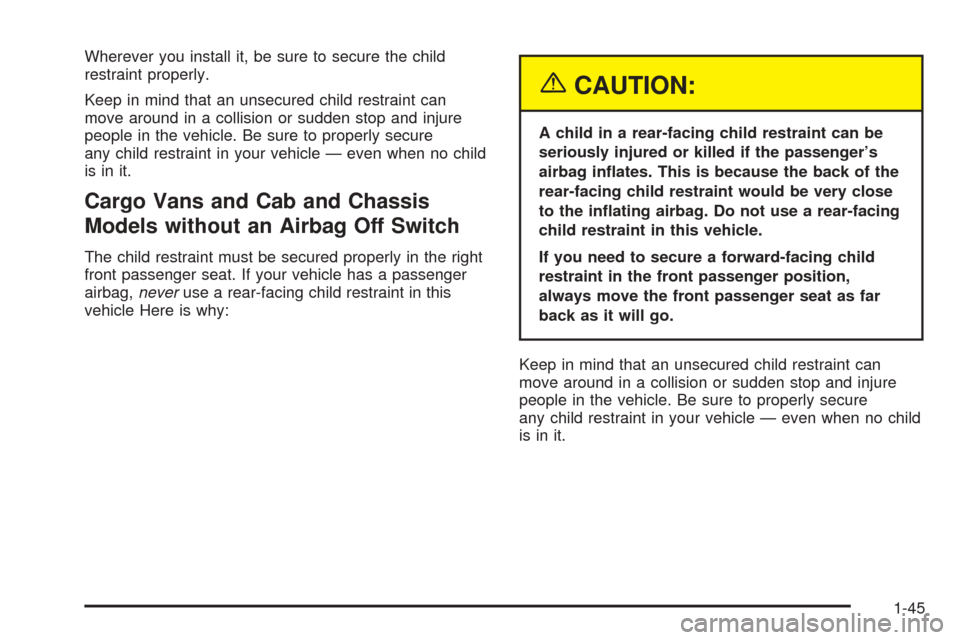
Wherever you install it, be sure to secure the child
restraint properly.
Keep in mind that an unsecured child restraint can
move around in a collision or sudden stop and injure
people in the vehicle. Be sure to properly secure
any child restraint in your vehicle — even when no child
is in it.
Cargo Vans and Cab and Chassis
Models without an Airbag Off Switch
The child restraint must be secured properly in the right
front passenger seat. If your vehicle has a passenger
airbag,neveruse a rear-facing child restraint in this
vehicle Here is why:
{CAUTION:
A child in a rear-facing child restraint can be
seriously injured or killed if the passenger’s
airbag in�ates. This is because the back of the
rear-facing child restraint would be very close
to the in�ating airbag. Do not use a rear-facing
child restraint in this vehicle.
If you need to secure a forward-facing child
restraint in the front passenger position,
always move the front passenger seat as far
back as it will go.
Keep in mind that an unsecured child restraint can
move around in a collision or sudden stop and injure
people in the vehicle. Be sure to properly secure
any child restraint in your vehicle — even when no child
is in it.
1-45
Page 52 of 388
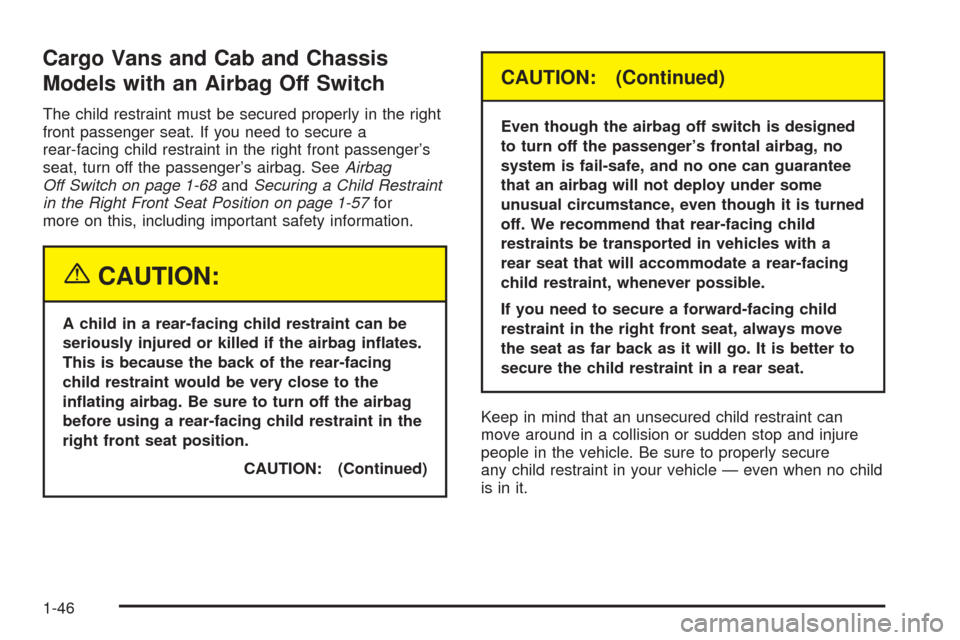
Cargo Vans and Cab and Chassis
Models with an Airbag Off Switch
The child restraint must be secured properly in the right
front passenger seat. If you need to secure a
rear-facing child restraint in the right front passenger’s
seat, turn off the passenger’s airbag. SeeAirbag
Off Switch on page 1-68andSecuring a Child Restraint
in the Right Front Seat Position on page 1-57for
more on this, including important safety information.
{CAUTION:
A child in a rear-facing child restraint can be
seriously injured or killed if the airbag in�ates.
This is because the back of the rear-facing
child restraint would be very close to the
in�ating airbag. Be sure to turn off the airbag
before using a rear-facing child restraint in the
right front seat position.
CAUTION: (Continued)
CAUTION: (Continued)
Even though the airbag off switch is designed
to turn off the passenger’s frontal airbag, no
system is fail-safe, and no one can guarantee
that an airbag will not deploy under some
unusual circumstance, even though it is turned
off. We recommend that rear-facing child
restraints be transported in vehicles with a
rear seat that will accommodate a rear-facing
child restraint, whenever possible.
If you need to secure a forward-facing child
restraint in the right front seat, always move
the seat as far back as it will go. It is better to
secure the child restraint in a rear seat.
Keep in mind that an unsecured child restraint can
move around in a collision or sudden stop and injure
people in the vehicle. Be sure to properly secure
any child restraint in your vehicle — even when no child
is in it.
1-46
Page 56 of 388
Passenger Van with an Airbag Off
Switch or Cargo Van
On passenger vans with an airbag off switch or on
cargo vans with a front passenger seat, the anchor for a
top strap is located at the rear of the seat cushion on
the right front passenger’s seat.
Lower Anchorages and Top Tethers
for Children (LATCH System)
Your vehicle may have the LATCH system. If it does,
there are anchors for the second row outside seating
positions.
This system, designed to make installation of child
restraints easier, does not use the vehicle’s safety belts.
Instead, it uses vehicle anchors and child restraint
attachments to secure the restraints. Some restraints
also use another vehicle anchor to secure a top
tether strap.
Passenger Van with an Airbag Off Switch
or Cargo Van
1-50
Page 64 of 388
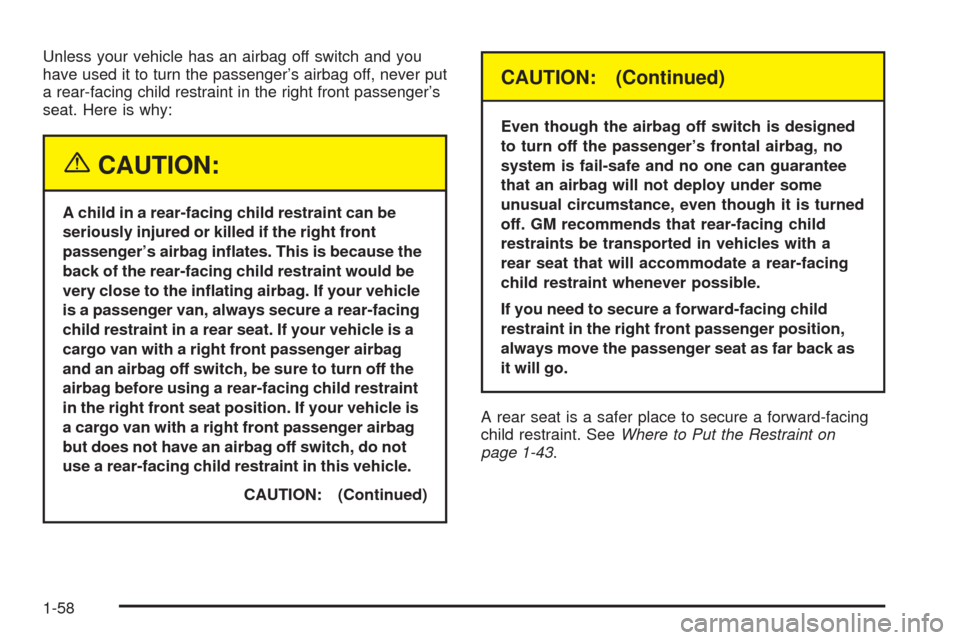
Unless your vehicle has an airbag off switch and you
have used it to turn the passenger’s airbag off, never put
a rear-facing child restraint in the right front passenger’s
seat. Here is why:
{CAUTION:
A child in a rear-facing child restraint can be
seriously injured or killed if the right front
passenger’s airbag in�ates. This is because the
back of the rear-facing child restraint would be
very close to the in�ating airbag. If your vehicle
is a passenger van, always secure a rear-facing
child restraint in a rear seat. If your vehicle is a
cargo van with a right front passenger airbag
and an airbag off switch, be sure to turn off the
airbag before using a rear-facing child restraint
in the right front seat position. If your vehicle is
a cargo van with a right front passenger airbag
but does not have an airbag off switch, do not
use a rear-facing child restraint in this vehicle.
CAUTION: (Continued)
CAUTION: (Continued)
Even though the airbag off switch is designed
to turn off the passenger’s frontal airbag, no
system is fail-safe and no one can guarantee
that an airbag will not deploy under some
unusual circumstance, even though it is turned
off. GM recommends that rear-facing child
restraints be transported in vehicles with a
rear seat that will accommodate a rear-facing
child restraint whenever possible.
If you need to secure a forward-facing child
restraint in the right front passenger position,
always move the passenger seat as far back as
it will go.
A rear seat is a safer place to secure a forward-facing
child restraint. SeeWhere to Put the Restraint on
page 1-43.
1-58
Page 65 of 388
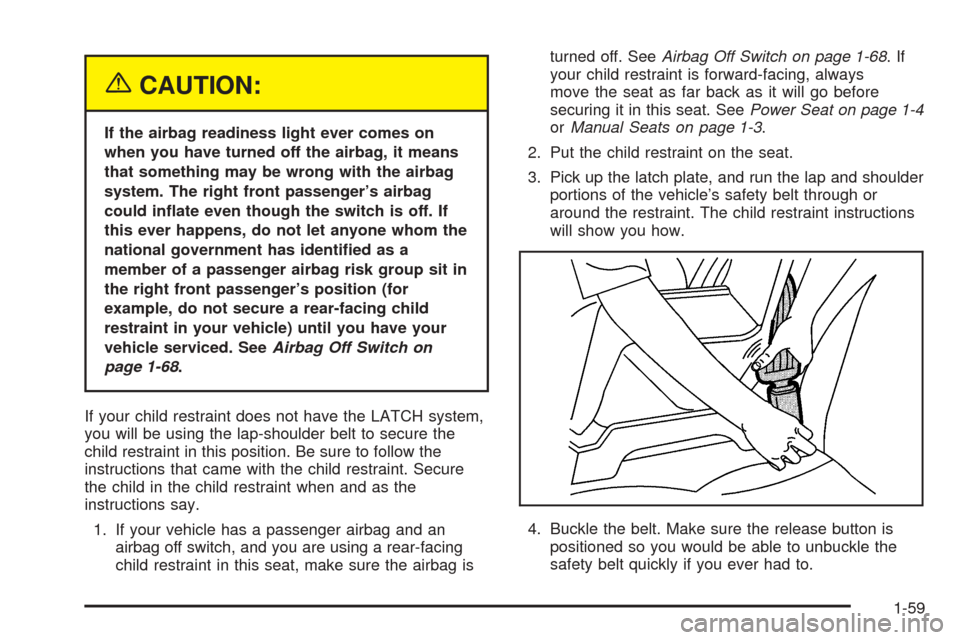
{CAUTION:
If the airbag readiness light ever comes on
when you have turned off the airbag, it means
that something may be wrong with the airbag
system. The right front passenger’s airbag
could in�ate even though the switch is off. If
this ever happens, do not let anyone whom the
national government has identi�ed as a
member of a passenger airbag risk group sit in
the right front passenger’s position (for
example, do not secure a rear-facing child
restraint in your vehicle) until you have your
vehicle serviced. SeeAirbag Off Switch on
page 1-68.
If your child restraint does not have the LATCH system,
you will be using the lap-shoulder belt to secure the
child restraint in this position. Be sure to follow the
instructions that came with the child restraint. Secure
the child in the child restraint when and as the
instructions say.
1. If your vehicle has a passenger airbag and an
airbag off switch, and you are using a rear-facing
child restraint in this seat, make sure the airbag isturned off. SeeAirbag Off Switch on page 1-68.If
your child restraint is forward-facing, always
move the seat as far back as it will go before
securing it in this seat. SeePower Seat on page 1-4
orManual Seats on page 1-3.
2. Put the child restraint on the seat.
3. Pick up the latch plate, and run the lap and shoulder
portions of the vehicle’s safety belt through or
around the restraint. The child restraint instructions
will show you how.
4. Buckle the belt. Make sure the release button is
positioned so you would be able to unbuckle the
safety belt quickly if you ever had to.
1-59
Page 67 of 388
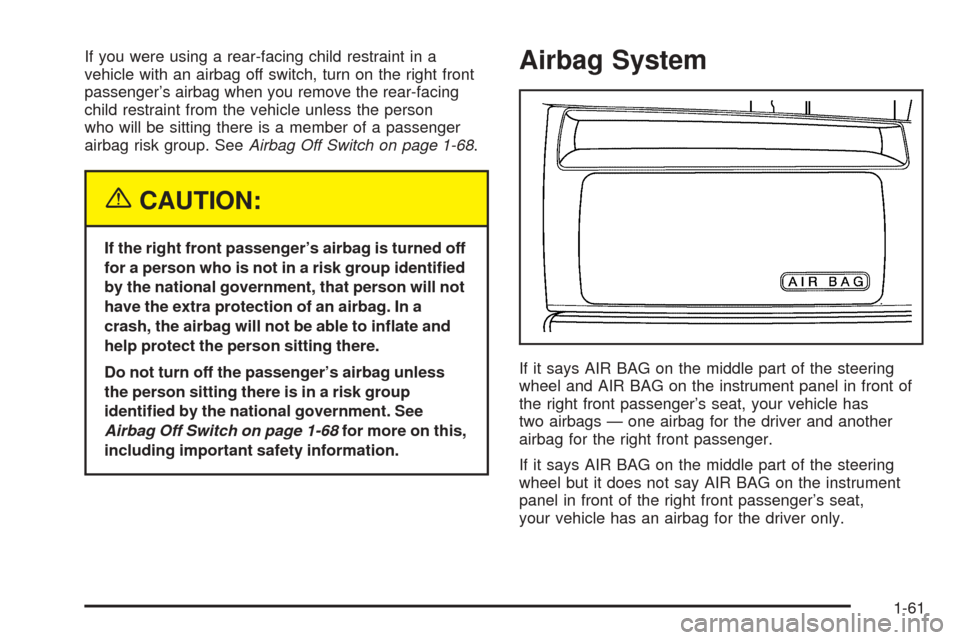
If you were using a rear-facing child restraint in a
vehicle with an airbag off switch, turn on the right front
passenger’s airbag when you remove the rear-facing
child restraint from the vehicle unless the person
who will be sitting there is a member of a passenger
airbag risk group. SeeAirbag Off Switch on page 1-68.
{CAUTION:
If the right front passenger’s airbag is turned off
for a person who is not in a risk group identi�ed
by the national government, that person will not
have the extra protection of an airbag. In a
crash, the airbag will not be able to in�ate and
help protect the person sitting there.
Do not turn off the passenger’s airbag unless
the person sitting there is in a risk group
identi�ed by the national government. See
Airbag Off Switch on page 1-68for more on this,
including important safety information.
Airbag System
If it says AIR BAG on the middle part of the steering
wheel and AIR BAG on the instrument panel in front of
the right front passenger’s seat, your vehicle has
two airbags — one airbag for the driver and another
airbag for the right front passenger.
If it says AIR BAG on the middle part of the steering
wheel but it does not say AIR BAG on the instrument
panel in front of the right front passenger’s seat,
your vehicle has an airbag for the driver only.
1-61
Page 68 of 388
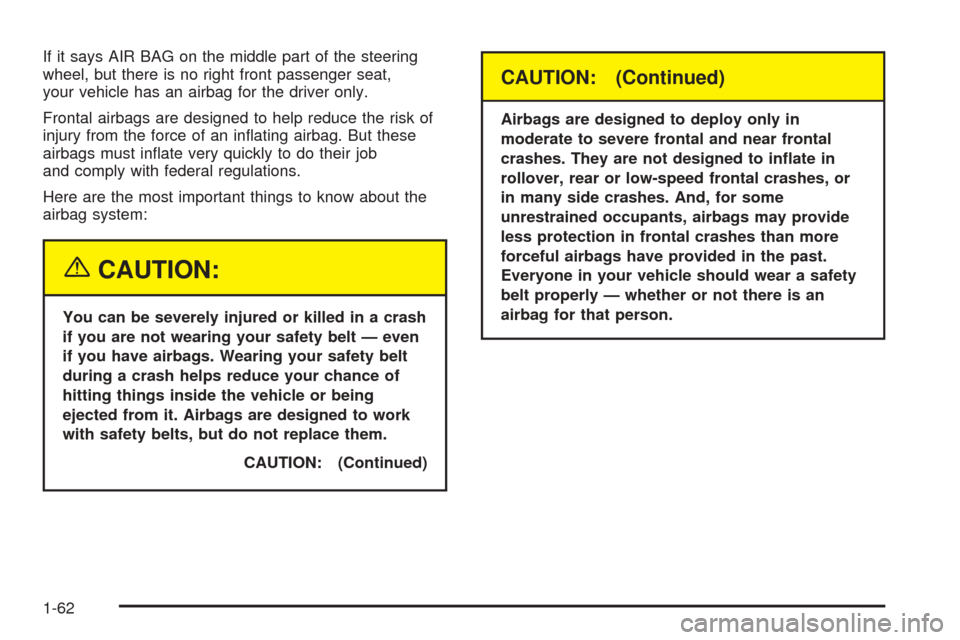
If it says AIR BAG on the middle part of the steering
wheel, but there is no right front passenger seat,
your vehicle has an airbag for the driver only.
Frontal airbags are designed to help reduce the risk of
injury from the force of an in�ating airbag. But these
airbags must in�ate very quickly to do their job
and comply with federal regulations.
Here are the most important things to know about the
airbag system:
{CAUTION:
You can be severely injured or killed in a crash
if you are not wearing your safety belt — even
if you have airbags. Wearing your safety belt
during a crash helps reduce your chance of
hitting things inside the vehicle or being
ejected from it. Airbags are designed to work
with safety belts, but do not replace them.
CAUTION: (Continued)
CAUTION: (Continued)
Airbags are designed to deploy only in
moderate to severe frontal and near frontal
crashes. They are not designed to in�ate in
rollover, rear or low-speed frontal crashes, or
in many side crashes. And, for some
unrestrained occupants, airbags may provide
less protection in frontal crashes than more
forceful airbags have provided in the past.
Everyone in your vehicle should wear a safety
belt properly — whether or not there is an
airbag for that person.
1-62